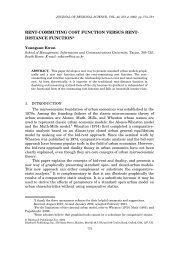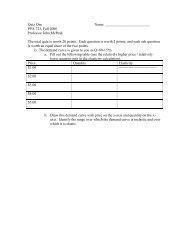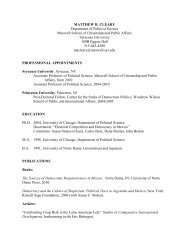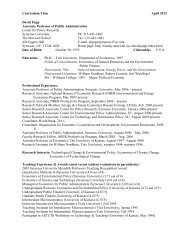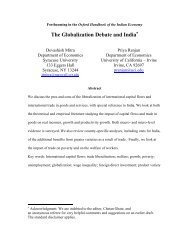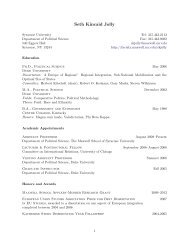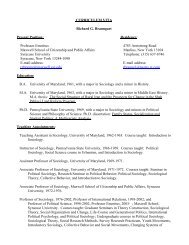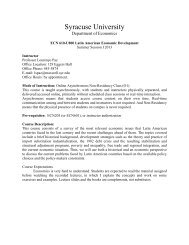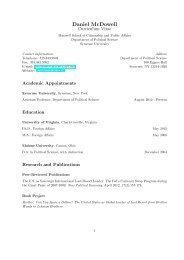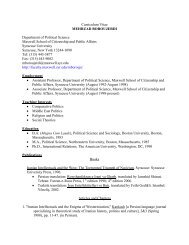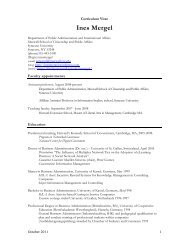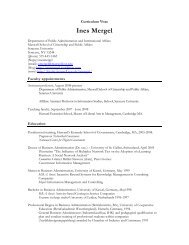ECN 765: Advanced International Trade - Syracuse University
ECN 765: Advanced International Trade - Syracuse University
ECN 765: Advanced International Trade - Syracuse University
You also want an ePaper? Increase the reach of your titles
YUMPU automatically turns print PDFs into web optimized ePapers that Google loves.
SYRACUSE UNIVERSITY<br />
DEPARTMENT OF ECONOMICS<br />
<strong>ECN</strong> <strong>765</strong>: <strong>Advanced</strong> <strong>International</strong> <strong>Trade</strong>:<br />
theory and Evidence<br />
Fall 2009<br />
Professor Mary E. Lovely<br />
131 Eggers Hall<br />
Office Hours: Mon 3-4, Fri. 9-10:30, and by appt.<br />
Office Phone: 443-9048<br />
melovely@maxwell.syr.edu<br />
COURSE DESCRIPTION<br />
Economics <strong>765</strong> presents international trade theory at the Ph.D. level. The course focuses<br />
almost entirely on general equilibrium approaches to modeling trading relations and to testing<br />
hypotheses derived from these models. Topics covered include models of trade with constant<br />
returns and perfect competition, models of trade with variable returns and imperfect competition,<br />
positive and normative analyses of commercial policy, the political economy of trade policy, and<br />
topics related to offshoring/outsourcing.<br />
To complete the Ph.D. sequence in trade and development, students should follow this<br />
course with Economics 865, Topics in <strong>International</strong> <strong>Trade</strong>. Lectures, class discussions, and<br />
assignments are geared toward developing competency in understanding and creating models of<br />
open economic systems. We will also assign a series of empirical exercises using the statistical<br />
program STATA. These exercises are a required part of the course. Problem sets, two take-home<br />
examinations, and a critical literature review allow students to demonstrate competency.<br />
Course Prerequisites: A working knowledge of multivariate calculus and linear algebra is<br />
required, as is completion of a Ph.D.-level course in microeconomic theory (Economics 611 or the<br />
equivalent).<br />
Course Requirements and Evaluation Procedures:<br />
1. Take-home examinations. Students are required to take two take-home exams. Each of the two<br />
exams accounts for 25 percent of the final grade.<br />
2. Literature Review. The literature review accounts for 20 percent of the final grade. Each<br />
student will pick a topic that he or she may wish to develop further. The student will prepare a
Economics <strong>765</strong>, Fall 2009, Syllabus -2-<br />
bibliography of papers that offer a theoretical basis for further investigation of the topic. From<br />
this bibliography, he or she will prepare a paper that surveys (integrates and critiques) the main<br />
papers on the topic (typically 3 or 4 papers). THE PAPER IS DUE AT NOON ON DECEMBER<br />
21, 2009. PAPERS SUBMITTED AFTER THIS DATE WILL NOT BE ACCEPTED.<br />
3. Problem Sets. Problem sets account for an additional 20 percent of the final grade.<br />
4. Course Participation. The remaining 10 percent of the grade will be determined by all aspects<br />
of course participation, including in-class and out-of-class discussion and problem sets. We<br />
expect all participants to have read (at least) all the assigned material by the first class for which<br />
they are assigned. This is a necessary condition for intelligent participation and, thus, for a<br />
passing grade. A grade of "A" for this course requires a more active approach to the material<br />
involving discussion or writing past the immediate content of the papers being presented.<br />
Policy on academic honesty: In completing all assignments in this course, absolute<br />
academic honesty is demanded of you. Plagiarism, in the form of unacknowledged use of<br />
another's ideas or expressions, will result in a failing grade for the course. If you are uncertain<br />
about the proper way to cite or extend others’ work, please see us before you submit your paper.<br />
For more information and the <strong>Syracuse</strong> <strong>University</strong> Academic Integrity Policy, see<br />
http://academicintegrity.syr.edu.<br />
Course Materials: The reading list contains more material than we can cover in one semester.<br />
Required readings are noted with an asterisk and are available through JSTOR or other online<br />
resources. Other listed readings may prove useful as supplements or as sources of ideas for further<br />
research.<br />
You are required to purchase one text, Robert Feenstra, <strong>Advanced</strong> <strong>International</strong> <strong>Trade</strong>:<br />
Theory and Evidence, Princeton <strong>University</strong> Press, 2004. We will also use empirical<br />
exercises from the site. Find datasets and programs for these exercises at:<br />
www.econ.ucdavis.edu/faculty/fzfeens.<br />
You may wish to consult the following textbooks and collections of articles.<br />
Wong, Kar-yiu, <strong>International</strong> <strong>Trade</strong> in Goods and Factor Mobility, MIT Press, 1995.<br />
Choi, E. Kwan and James Harrigan, Handbook of <strong>International</strong> <strong>Trade</strong>, Blackwell<br />
Publishing, 2003.<br />
Grossman, Gene, ed., Imperfect Competition and <strong>International</strong> <strong>Trade</strong>, MIT Press, 1992.<br />
Woodland, A.D., <strong>International</strong> <strong>Trade</strong> and Resource Allocation, North-Holland, 1982.<br />
(This book is currently out of print. The library has it.)<br />
Data and Information Sources on <strong>Trade</strong> and <strong>Trade</strong> Policies<br />
World Bank's World Development Indicators (import and export duties, trade volumes, other
Economics <strong>765</strong>, Fall 2009, Syllabus -3-<br />
cross-national data). Maxwell network users can find this database on the P: drive.<br />
United Nations COMTRADE data base: http://comtrade.un.org/<br />
UNCTAD <strong>Trade</strong> Analysis and Information System (TRAINS):<br />
http://www.unctad.org/trains/index.htm<br />
US Census Bureau Foreign <strong>Trade</strong> Statistics: http://www.census.gov/foreign-trade/www/<br />
Detailed US and Canada imports by source (6-digit HS) from Industry Canada:<br />
http://strategis.ic.gc.ca/sc_mrkti/tdst/engdoc/tr_homep.html<br />
Jon Haveman’s <strong>International</strong> <strong>Trade</strong> Data:<br />
http://www.macalester.edu/research/economics/PAGE/HAVEMAN/<strong>Trade</strong>.Resources/<strong>Trade</strong>Data.h<br />
tml<br />
Office of the United States <strong>Trade</strong> Representative National <strong>Trade</strong> Estimate Report on Foreign<br />
<strong>Trade</strong> Barriers: http://www.ustr.gov/Document_Library/Reports_Publications/Section_Index.html<br />
U.S. Department of State Country Summaries: http://www.state.gov/r/pa/ei/bgn/<br />
The Global <strong>Trade</strong> Negotiations Home Page: This Harvard-based web site contains extensive links<br />
to further material: http://www.cid.harvard.edu/cidtrade
Economics <strong>765</strong>, Fall 2009, Syllabus -4-<br />
A HANDY TABLE OF TOPICS AND DUE DATES<br />
Class DATE TOPIC NOTES<br />
1 Aug. 31 Introduction to Course<br />
2 Sept. 2 The GNP Function and the Four-Equation System<br />
3 Sept. 7 Rybczynski Theorem and Magnification Effect<br />
4 Sept. 9 Stolper-Samuelson<br />
5 Sept. 14 Ricardian Model - theory PS #1 Due<br />
6 Sept. 16<br />
7 Sept. 23 Ricardian Model – empirical<br />
8 Sept. 30 The Heckscher-Ohlin Model<br />
9 Oct. 5<br />
10 Oct. 7 Testing and Estimating the Neoclassical Model<br />
11 Oct. 12<br />
12 Oct. 14 Ricardo-Viner Model PS #2 Due<br />
13 Oct. 19 Many Goods and Factors<br />
14 Oct.21 <strong>Trade</strong> in Intermediate Inputs and Wages<br />
Oct. 23 Take-Home Exam Due<br />
15 Oct. 26 <strong>Trade</strong> and the Environment<br />
16 Oct. 28 Gains from <strong>Trade</strong><br />
17 Nov. 2 Gains from <strong>Trade</strong><br />
18 Nov. 4 Increasing Returns and <strong>International</strong> <strong>Trade</strong><br />
19 Nov. 9 Increasing Returns and <strong>International</strong> <strong>Trade</strong><br />
20 Nov. 11 Increasing Returns and <strong>International</strong> <strong>Trade</strong><br />
21 Nov. 16 Increasing Returns and <strong>International</strong> <strong>Trade</strong> PS #3 Due<br />
22 Nov. 18 <strong>Trade</strong> Policy: Welfare Effects<br />
23 Nov.23 <strong>Trade</strong> Policy: Welfare Effects<br />
24 Nov.30 <strong>Trade</strong> Policy: Political Economy<br />
25 Dec. 2 <strong>Trade</strong> Policy: Political Economy<br />
26 Dec. 7 Firm Heterogeneity and <strong>Trade</strong><br />
27 Dec. 9 Firm Heterogeneity and <strong>Trade</strong> PS #4 Due<br />
28 Dec. 14 Gravity Approaches<br />
Dec. 16 Take-Home Exam Due by 5pm<br />
Dec. 21 Critical Literature Review Due by Noon
Class 1: Introduction to the Course<br />
Class 2: The GNP (or Revenue) Function<br />
Economics <strong>765</strong>, Fall 2009, Syllabus -5-<br />
SCHEDULE OF CLASSES<br />
*Silberberg, E., 1990, “General Equilibrium II: Nonlinear Models,” Chapter 16,<br />
The Structure of Economics, McGraw-Hill.<br />
Dixit, A.K., 1990, Optimization and Economic Theory, Oxford <strong>University</strong> Press, 2nd<br />
Edition. Chapter 5, "Maximum Value Functions."<br />
Class 3 and 4: Comparative Statics of the Production Sector<br />
* Chapter 1 in Robert Feenstra, 2004, <strong>Advanced</strong> <strong>International</strong> <strong>Trade</strong>, Princeton <strong>University</strong><br />
Press.<br />
*Mussa, M., 1979, “The Two-Sector Model in Terms of its Dual: A Geometric<br />
Exposition,” Journal of <strong>International</strong> Economics 9: 513-526.<br />
*Jones, R.W., 1965, “The Structure of Simple General Equilibrium Models,”<br />
Journal of Political Economy 73:557-572, Sections 1-5.<br />
Classes 5 and 6: The Ricardian Model and the Theory of Comparative Advantage<br />
*Dornbusch, R., S. Fischer, and P.A. Samuelson, 1977, “Comparative Advantage,<br />
<strong>Trade</strong>, and Payments in a Ricardian Model with a Continuum of Goods,” American<br />
Economic Review 67:823-839.<br />
*Deardorff, A., 1980, “The General Validity of the Law of Comparative<br />
Advantage,” Journal of Political Economy 88:941-957.<br />
Chipman, J.S., 1965, “A Survey of the Theory of <strong>International</strong> <strong>Trade</strong>: Part 1, The<br />
Classical Theory,” Econometrica: 477-519.<br />
Class 7: Empirical Tests of Comparative Advantage<br />
*Bernhofen, Daniel M. and John C. Brown, “A Direct Test of the Theory of<br />
Comparative Advantage: The Case of Japan,” Journal of Political Economy 112<br />
(1): 48-67.<br />
Bernhofen, Daniel M. and John C. Brown, 2005, “An Empirical Assessment of the<br />
Comparative Advantage Gains from <strong>Trade</strong>: Evidence from Japan,” American<br />
Economic Review 95 (1): 208-225.
Class 8 and 9: The Heckscher-Ohlin Model<br />
Economics <strong>765</strong>, Fall 2009, Syllabus -6-<br />
* Chapter 2 in Robert Feenstra, <strong>Advanced</strong> <strong>International</strong> <strong>Trade</strong>.<br />
*Deardorff, A., 1979, “Weak Links in the Chain of Comparative Advantage,”<br />
Journal of <strong>International</strong> Economics 9:197-209.<br />
Deardorff, A., 1982, “The General Validity of the Heckscher-Ohlin Theorem,”<br />
American Economic Review 2:683-694.<br />
Dixit, A. and A. Woodland, 1982, “The Relationship between Factor Endowments and<br />
Commodity <strong>Trade</strong>,” Journal of <strong>International</strong> Economics 13:201-214.<br />
Classes 10-11: Testing and Estimating the Neoclassical Model<br />
*Trefler, Daniel, 1995, “The Case of the Missing <strong>Trade</strong> and Other Mysteries,” American<br />
Economic Review 85: 1029-1046.<br />
*Romalis, John, 2004, “Factor Proportions and the Commodity Structure of <strong>Trade</strong>,”<br />
American Economic Review 94:67-97.<br />
*Davis, Donald R. and David E. Weinstein, 2003, “The Factor Content of <strong>Trade</strong>,”<br />
Handbook of <strong>International</strong> <strong>Trade</strong>, in E. K. Choi and J. Harrigan, eds., Handbook of<br />
<strong>International</strong> <strong>Trade</strong>, Oxford: Blackwell.<br />
Harrigan, James, 1997, “Technology, Factor Supplies, and <strong>International</strong> Specialization:<br />
Estimating the Neoclassical Model,” American Economic Review 87: 475-494.<br />
Bowen H. P., E. E. Leamer, and L. Sveikauskas, 1987, “Multicountry, Multifactor Tests of<br />
the Factor Abundance Theory,” American Economic Review 77:599-620.<br />
Trefler, Daniel, 1993, “<strong>International</strong> Factor Price Differences: Leontief Was Right!”<br />
Journal of Political Economy 101:961-987.<br />
Class 12: The Ricardo-Viner Model<br />
*Mussa, M., 1974, “Tariffs and the Distribution of Income: The Importance of<br />
Factor Specificity, Substitutability, and Intensity in the Short and Long Run,”<br />
Journal of Political Economy 82: 1191-1203.<br />
*Jones, R.W., 1971, “A Three-Factor Model in Theory, <strong>Trade</strong>, and History,” in<br />
<strong>Trade</strong>, Balance of Payments, and Growth:Essays in Honor of C.P. Kindleberger,<br />
J.N. Bhagwati, ed., North-Holland, Amsterdam.
Classes 13: Many Goods and Factors<br />
Economics <strong>765</strong>, Fall 2009, Syllabus -7-<br />
*Chapter 3 in <strong>Advanced</strong> <strong>International</strong> <strong>Trade</strong> by Robert Feenstra.<br />
*Jones, R.W., and J.A. Scheinkman, 1977, “The Relevance of the Two-Sector<br />
Production Model in <strong>Trade</strong> Theory,” Journal of Political Economy 85:909-935.<br />
*Davis, Donald R., and David E. Weinstein, 2001, “An Account of Global Factor<br />
<strong>Trade</strong>,” American Economic Review 91:1423-53.<br />
Ethier, W. J., “Higher Dimensional Issues in <strong>Trade</strong> Theory,” in the Handbook of<br />
<strong>International</strong> Economics, Volume I, Ch. 3, pp 142-144, 150-152, 162-163.<br />
Jones, R.W., 1985, “Relative Prices and Real Factor Rewards: A Reinterpretation,”<br />
Economic Letters 19:47-49.<br />
Class 14: <strong>Trade</strong> in Intermediate Inputs and Wages<br />
*Chapter 4 in <strong>Advanced</strong> <strong>International</strong> <strong>Trade</strong> by Robert Feenstra.<br />
*Slaughter, Matthew, 2001, “<strong>International</strong> <strong>Trade</strong> and Labor-Demand Elasticities,” Journal<br />
of <strong>International</strong> Economics, 54:1, 27-56.<br />
*Hasan, R., D. Mitra, and K.V. Ramaswamy, 2007, “<strong>Trade</strong> Reforms, Labor Regulations,<br />
and Labor-Demand Elasticities: Empirical Evidence from India,” The Review of<br />
Economics and Statistics 89:3, 466-481.<br />
Class 15: Applications of the Theory: <strong>Trade</strong> and the Environment<br />
*Copeland, Brian R. and M. Scott Taylor, 1994. “North-South <strong>Trade</strong> and the<br />
Environment,” Quarterly Journal of Economics V: 755-787.<br />
*Judith M. Dean and Mary E. Lovely, 2008, “<strong>Trade</strong> Growth, Production Fragmentation,<br />
and the Environment, NBER Working Paper #13860<br />
Classes 16-17: Gains from <strong>Trade</strong><br />
*Chapter 6 in <strong>Advanced</strong> <strong>International</strong> <strong>Trade</strong> by Robert Feenstra.<br />
*Chapters 18 and 19 in Lectures on <strong>International</strong> <strong>Trade</strong> by Bhagwati, Panagariya and<br />
Srinivasan.<br />
Dixit, A., 1986, “Tax Policy in Open Economies,” sections 1, 2 and 3, in Handbook of<br />
Public Economics, Volume I.
Economics <strong>765</strong>, Fall 2009, Syllabus -8-<br />
Classes 18-21: Increasing Returns and <strong>International</strong> <strong>Trade</strong>: Theory and Empirics<br />
*Krugman, P., 1979, “Increasing Returns, Monopolistic Competition and <strong>International</strong><br />
<strong>Trade</strong>,” Journal of <strong>International</strong> Economics 9:469-479.<br />
*Krugman, P., 1995, “Increasing Returns, Imperfect Competition and the Positive Theory<br />
of <strong>International</strong> <strong>Trade</strong>,” in G. Grossman and K. Rogoff, eds., Handbook of <strong>International</strong><br />
Economics Vol 3, North-Holland.<br />
*Deardorff, Alan, 2003, “Introduction to External Increasing Returns,” mimeo.<br />
*Chapter 5 in <strong>Advanced</strong> <strong>International</strong> <strong>Trade</strong> by Robert Feenstra.<br />
*Debaere, Peter, 2005, “Monopolistic Competition and <strong>Trade</strong>, Revisited: Testing the<br />
Model Without Testing for Gravity,” Journal of <strong>International</strong> Economics.<br />
*Antweiler, W. and Trefler, D. 2002, “Increasing Returns and All That: A View from<br />
<strong>Trade</strong>,” American Economic Review 92:93-119.<br />
Chapter 11 in Lectures on <strong>International</strong> <strong>Trade</strong> by Bhagwati, Panagariya and Srinivasan.<br />
Dixit, A. and V. Norman, 1980, “Product Differentiation and Intraindustry <strong>Trade</strong>,”<br />
Chapter 9, Theory of <strong>International</strong> <strong>Trade</strong>: A Dual, General Equilibrium Approach,<br />
Cambridge, Cambridge <strong>University</strong> Press.<br />
Ethier, Wilfred J., 1982, “National and <strong>International</strong> Returns to Scale in the Modern<br />
Theory of <strong>International</strong> <strong>Trade</strong>,” American Economic Review 72:388-405.<br />
Krugman, Paul, 1980, "Scale Economies, Product Differentiation and the Pattern of<br />
<strong>Trade</strong>," American Economic Review 70:950-959.<br />
Hanson, Gordon and Chong Xiang, 2004, “The Home-Market Effect and Bilateral <strong>Trade</strong><br />
Patterns,” American Economic Review 94(4):1108-1129.<br />
Lovely, Mary, Devashish Mitra, and Cong Pham Si, 2007, “The Home-Market Effect and<br />
Bilateral <strong>Trade</strong> Patterns: A Comment,” <strong>Syracuse</strong> <strong>University</strong>, mimeo.<br />
Classes 22-25: <strong>Trade</strong> Policy: Welfare Effects, Political Economy<br />
*Chapters 7, 8 and 9 in <strong>Advanced</strong> <strong>International</strong> <strong>Trade</strong> by Robert Feenstra.<br />
*Rodrik, D., 1995, “The Political Economy of <strong>Trade</strong> Policy,” Ch. 28 in Gene Grossman<br />
and Kenneth Rogoff, eds., Handbook of <strong>International</strong> Economics Vol 3, North-Holland.
Economics <strong>765</strong>, Fall 2009, Syllabus -9-<br />
*Gawande, K. and Krishna, P., 2003, “The Political Economy of <strong>Trade</strong> Policy: Empirical<br />
Approaches,” in E. Kwan Choi and James Harrigan, eds,.Handbook of <strong>International</strong> <strong>Trade</strong>,<br />
Blackwell Publishers.<br />
Mayer, W., 1984, “Endogenous Tariff Formation,” American Economic Review 74(5),<br />
970-985.<br />
*Grossman, G and Helpman, E., 1994, “Protection for Sale,” American Economic Review<br />
84 (4), 833-850.<br />
*Goldberg, P and Maggi, G. “Protection for Sale: An Empirical Investigation,” American<br />
Economic Review 89(5), 1135-1155.<br />
*Gawande, K and Bandyopadhyay, U., 2000, “Is Protection for Sale? A Test of the<br />
Grossman-Helpman Theory of Endogenous Protection, Review of Economics and Statistics<br />
82(1), 139-152.<br />
*Mitra, D., Thomakos, D. and Ulubasoglu, M., 2002 “ ‘Protection for Sale’ In A<br />
Developing Country: Democracy vs. Dictatorship,” Review of Economics and Statistics<br />
84(3), 497-508.<br />
*Dutt, P. and Mitra, D., 2002 “Endogenous <strong>Trade</strong> Policy Through Majority Voting: An<br />
Empirical Investigation,” Journal of <strong>International</strong> Economics 58(1), 107-134.<br />
Findlay, R. and Wellisz, S., 1982, “Endogenous Tariffs, the Political Economy of <strong>Trade</strong><br />
Restrictions and Welfare,” Jagdish Bhagwati ed., Import Competition and Response,<br />
<strong>University</strong> of Chicago Press, 223-234.<br />
Helpman, E., Politics and trade policy, in D.M.Kreps and K.F.Wallis (eds.), Advances in<br />
Economics and Econometrics: Theory and Applications (New York: Cambridge <strong>University</strong><br />
Press) 1997, pp. 19-45.<br />
Mitra, D., 1999, “Endogenous Lobby Formation and Endogenous Protection: A Long Run<br />
Model of <strong>Trade</strong> Policy Determination,” American Economic Review 89(5), December<br />
1999, pp. 1116-1134.<br />
Gawande, K., Krishna, P. and Robbins, M., 2002, “Foreign Lobbies and US <strong>Trade</strong> Policy,”<br />
mimeo, Brown <strong>University</strong>
Classes 26-27: Firm Heterogeneity and <strong>Trade</strong><br />
Economics <strong>765</strong>, Fall 2009, Syllabus -10-<br />
*Helpman, E. (2006) “<strong>Trade</strong>, FDI, and the organization of firms,” Journal of Economic<br />
Literature 44: 589-630.<br />
*Melitz, Marc J. (2003), “The Impact of <strong>Trade</strong> on Intra-Industry Reallocations and<br />
Aggregate Industry Productivity,” Econometrica, 71:6, pp. 1695-1725.<br />
*Bernard, A.B., J. Eaton, J.B. Jensen and S. Kortum (2003), “Plants and Productivity in<br />
<strong>International</strong> <strong>Trade</strong>,” American Economic Review 93(4), September, pp. 1268-1290.<br />
Eaton, Jonathan, Samuel Kortum, and Francis Kramarz (2003), “An Anatomy of<br />
<strong>International</strong> <strong>Trade</strong>: Evidence from French Firms,” mimeo, NYU.<br />
Eaton, Jonathan, Samuel Kortum, and Francis Kramarz (2003), “Dissecting <strong>Trade</strong>: Firms,<br />
Industries, and Export Destinations,” AER Papers and Proceedings, 94, pp. 150-154.<br />
*Chaney, Thomas (2005), “Distorted Gravity: The Intensive and Extensive Margins of<br />
<strong>International</strong> <strong>Trade</strong>,” American Economic Review 98(4), 1707-21.<br />
Class 28: Gravity Approaches<br />
*Helpman, Elhanan, Marc Melitz, and Yona Rubenstein, 2004, “Trading Partners and<br />
Trading Volumes, August 26, 2004, mimeo<br />
Anderson, James E. and Eric van Wincoop, 2003, “Gravity with Gravitas: A Solution to<br />
the Border Puzzle,” American Economic Review 93 (1): 170-192.<br />
Harrigan, James, 2003, “Specialization and the Volume of Production: Do the Data Obey<br />
the Laws?” in E. K. Choi and J. Harrigan, eds., Handbook of <strong>International</strong> <strong>Trade</strong>, Oxford:<br />
Blackwell.




